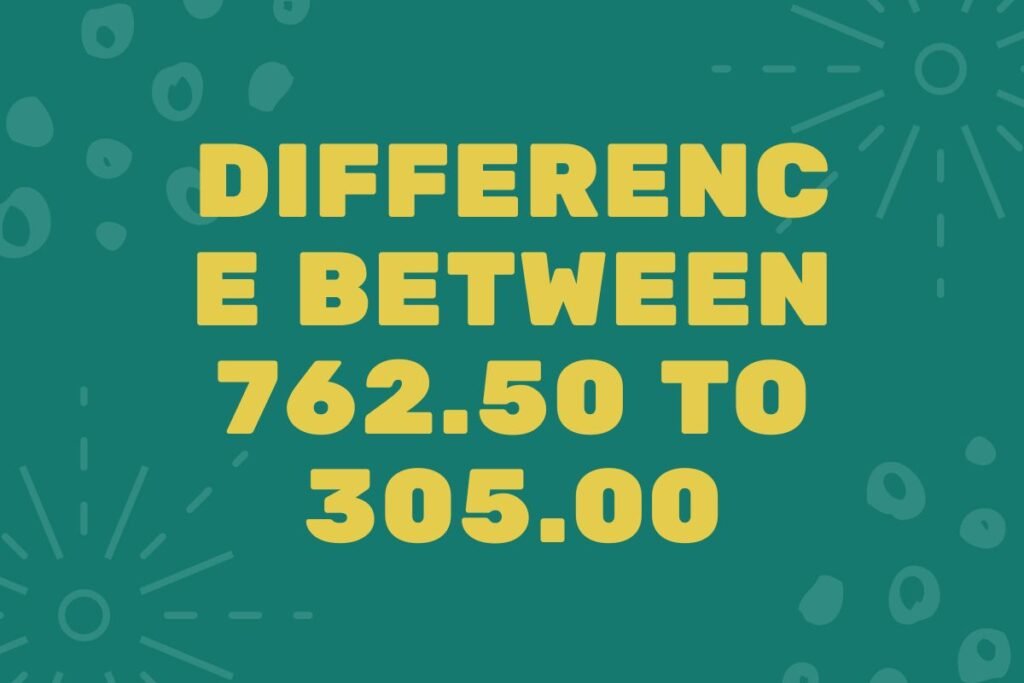Introduction
When navigating the world of financial analysis, trading, or even simple comparison exercises, numbers often play a pivotal role in understanding the underlying shifts and patterns. One common query arises when individuals compare two distinct numbers, such as 762.50 and 305.00. While the difference between these two figures may seem straightforward at first glance, it can reveal critical insights that go beyond a mere subtraction.
In this article, we delve into the significance of the difference between 762.50 to 305.00, providing a detailed exploration of the mathematical, economic, and practical implications. Whether you’re involved in finance, trading, or simply trying to understand number-based decisions, this guide will help clarify the relevance of such comparisons.
Understanding the Difference: A Basic Mathematical Approach
At the core, calculating the difference between 762.50 and 305.00 is a simple arithmetic operation:
762.50 – 305.00 = 457.50
This result, 457.50, represents the absolute difference between the two numbers. However, the context in which these numbers are used can significantly impact the interpretation of this difference. Let’s explore some of these contexts in greater detail.
1. The Financial Perspective: Value and Change
In the financial world, even slight differences in numbers can have significant implications. Let’s break down how these differences are viewed from a financial standpoint.
Market Analysis
In stock trading, commodities, or foreign exchange markets, prices frequently fluctuate. A difference of 457.50 might seem small when comparing larger asset values, but it can represent a substantial percentage change in certain markets. To gain better insight into this, consider the following formula to calculate percentage change:
Percentage Change=DifferenceOriginal Value×100\text{Percentage Change} = \frac{\text{Difference}}{\text{Original Value}} \times 100For the difference between 762.50 to 305.00, applying the formula would give:
Percentage Change=457.50762.50×100=60.0%\text{Percentage Change} = \frac{457.50}{762.50} \times 100 = 60.0\%Thus, the difference represents a 60% reduction, which is significant in contexts like stock prices or commodity values.
Profit and Loss Scenarios
For businesses or individuals tracking profitability, understanding the magnitude of changes in value can affect strategic decisions. A price drop from 762.50 to 305.00 can drastically impact margins, revenues, and overall business strategies. Recognizing this 60% change provides vital insight into cost-benefit analyses and business sustainability.
2. The Economic Impact: The Bigger Picture
In an economic context, the difference between two figures can symbolize broader shifts in economic conditions, such as inflation, interest rates, or market demand. Here’s how the 762.50 to 305.00 difference could be interpreted in real-world economics:
Inflation and Purchasing Power
Over time, inflation can erode the purchasing power of money. A price shift from 762.50 to 305.00 could reflect how inflation or deflation impacts the real value of goods or services. Understanding the effects of such price changes is essential for businesses, consumers, and governments in making informed decisions.
Currency Exchange and Global Trade
A shift in the exchange rate, such as from 762.50 units of one currency to 305.00 units of another, could indicate significant shifts in the global market. This difference might suggest changes in the international value of currencies, influencing trade balances, imports, exports, and geopolitical relations.
3. Practical Applications: Real-Life Scenarios
Beyond the financial and economic domains, the difference between 762.50 and 305.00 can be seen in numerous practical contexts, such as:
Consumer Pricing: Retail and Wholesale
When comparing the price of products or services in retail versus wholesale markets, differences like 457.50 could signify the gap between retail and bulk pricing. This is particularly useful for businesses looking to optimize purchasing decisions or for consumers seeking to understand how buying in bulk can lead to savings.
Cost of Goods Sold (COGS)
In manufacturing, understanding how the difference between 762.50 and 305.00 affects production costs is crucial. If these values represent unit costs at two different stages of production or two different suppliers, recognizing the cost variance allows companies to make cost-effective decisions.
4. Visualizing the Difference: A Comparison Chart
To provide clearer insights into how the difference between 762.50 to 305.00 compares across various domains, here’s a practical chart:
| Category | Value 1 | Value 2 | Difference | Percentage Change |
|---|---|---|---|---|
| Financial Price | 762.50 | 305.00 | 457.50 | 60% |
| Product Price (Retail) | 762.50 | 305.00 | 457.50 | 60% |
| Currency Exchange | 762.50 | 305.00 | 457.50 | 60% |
| Manufacturing Cost | 762.50 | 305.00 | 457.50 | 60% |
This chart exemplifies the different applications of such a difference, emphasizing the significance across industries.
5. Insights and Key Takeaways
Understanding the difference between 762.50 to 305.00 is more than just performing arithmetic. This difference holds substantial value across various sectors, including finance, economics, retail, and manufacturing. Recognizing the context of these differences and applying the appropriate analysis methods can provide a deeper understanding of the potential impact on business, trade, and economic conditions.
Key takeaways include:
- A 60% difference represents significant value changes in markets, whether it’s in pricing, exchange rates, or cost analysis.
- Percentage changes provide valuable insights into market trends, profitability, and cost adjustments.
- The 457.50 difference holds practical applications in both consumer pricing strategies and manufacturing cost optimizations.
Conclusion
The difference between 762.50 to 305.00 offers more than just a numerical subtraction; it unveils critical insights into value changes, percentage fluctuations, and economic impacts. Whether you’re a trader, business owner, or consumer, understanding such differences equips you with the knowledge to make more informed decisions.
By recognizing the implications of this 457.50 difference, you can better navigate pricing strategies, market trends, and cost-effectiveness in both personal and professional spheres. Keep exploring how minor numerical changes can lead to large-scale shifts in real-world outcomes.


